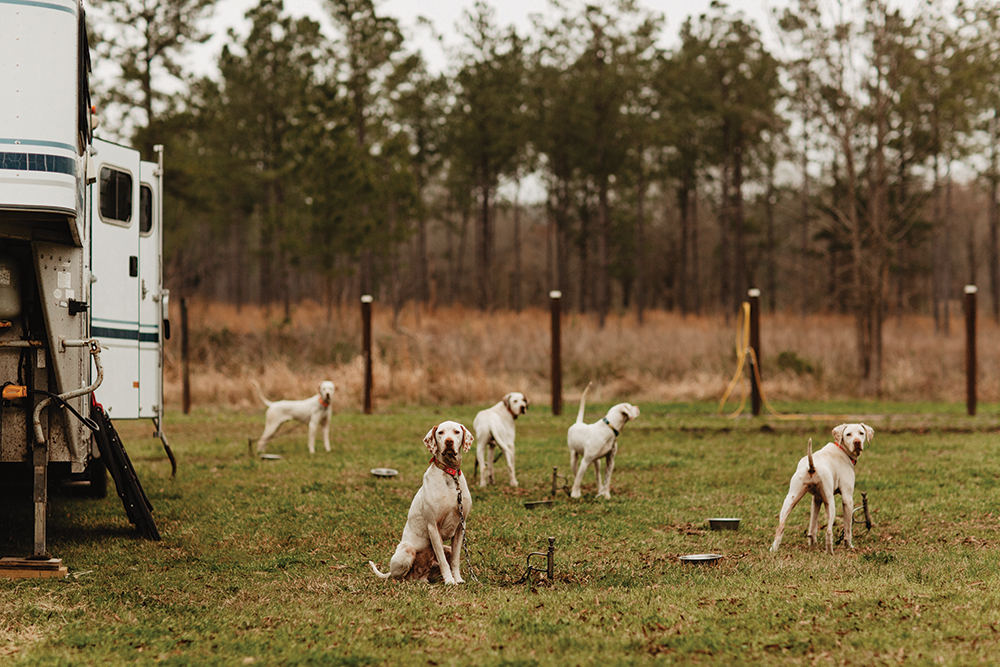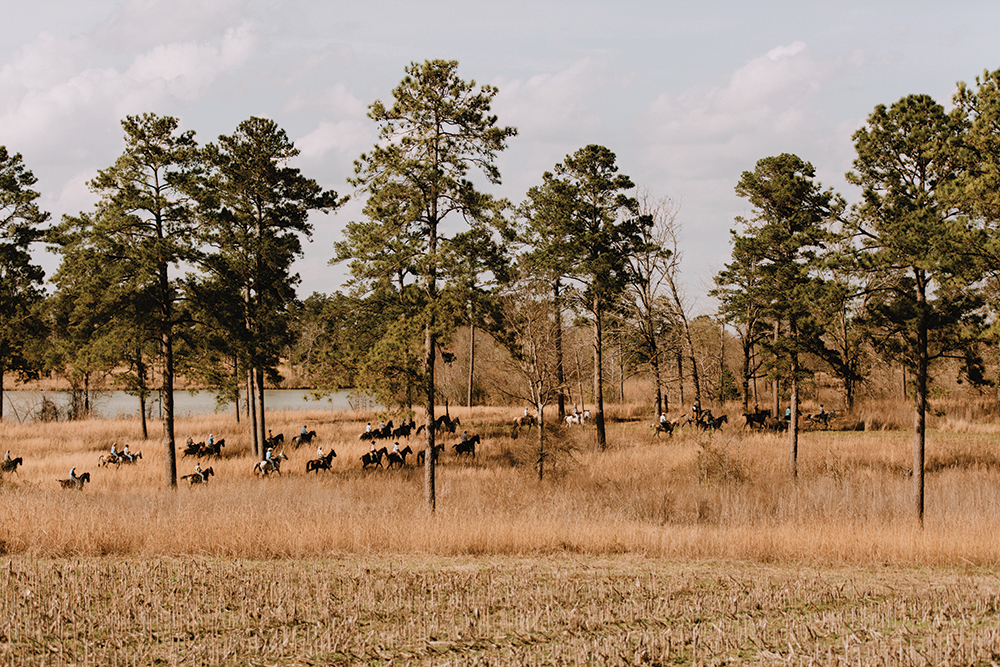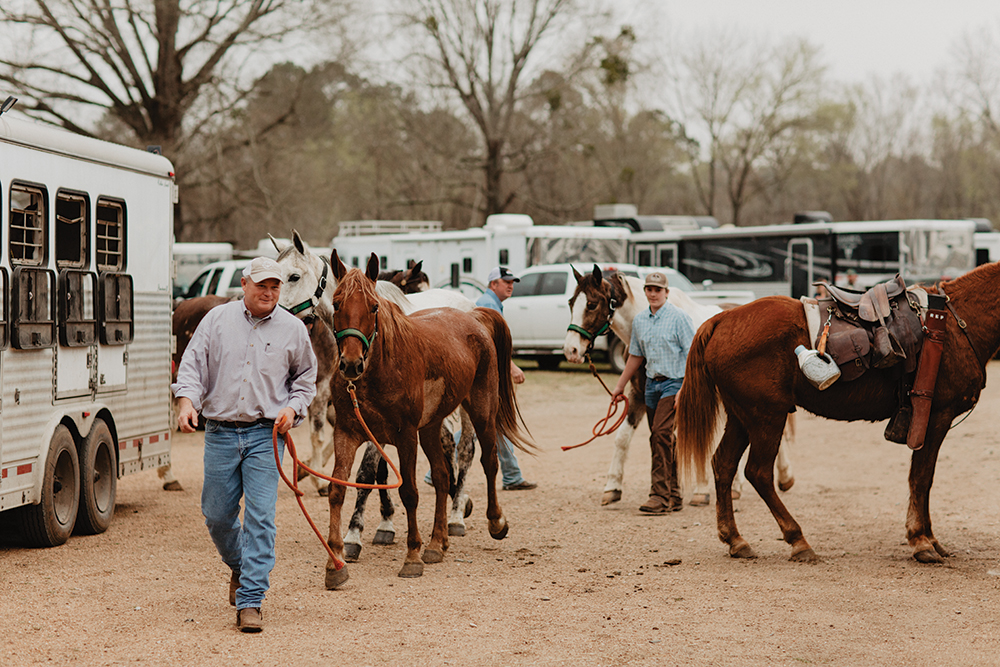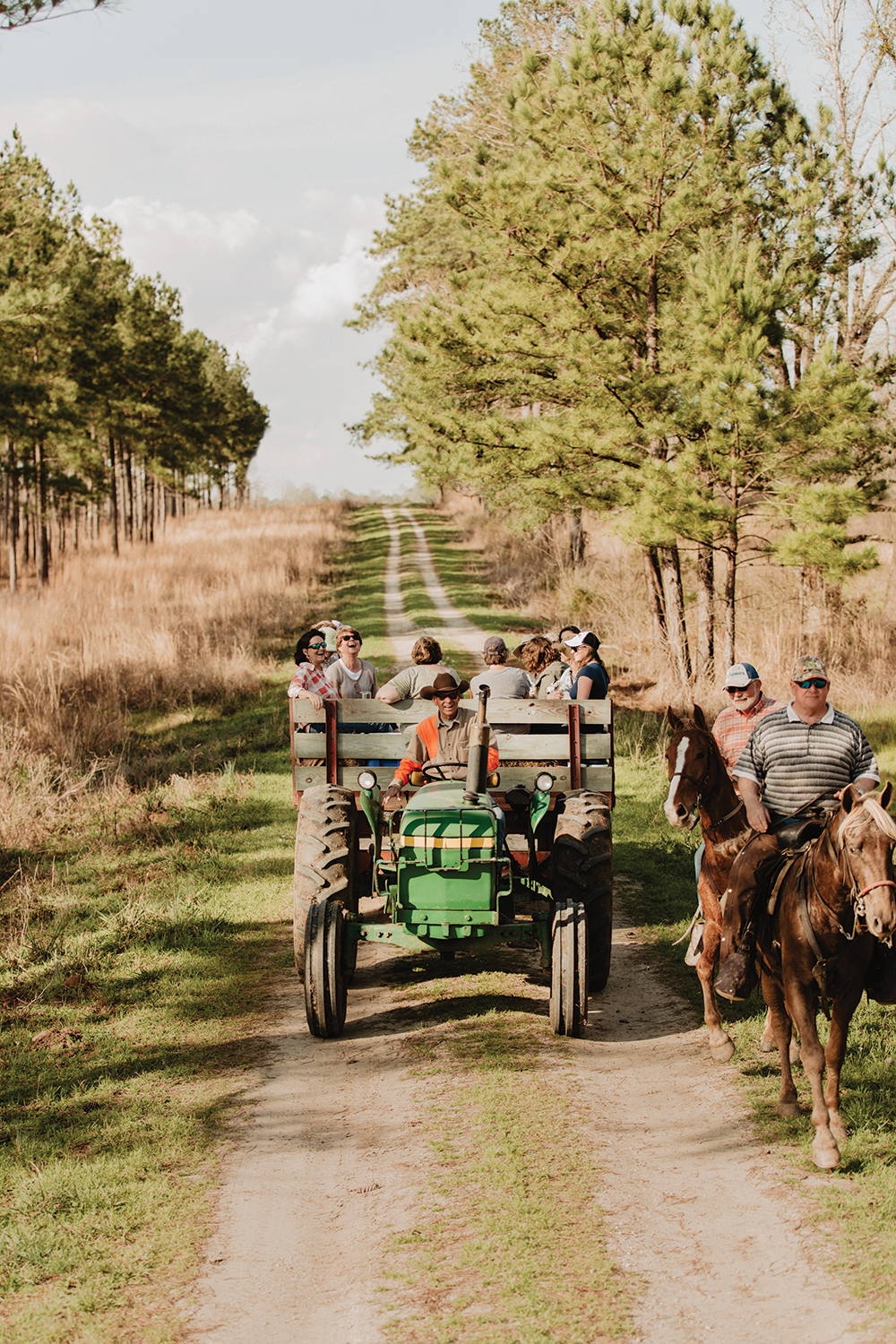Dogs On Trial

It begins with a whiff, a subtle scent on the lightest of breezes that pulls a dog’s nose with the delicacy of an air hammer. His undivided attention is immediately surrendered to the cleverly hidden covey in the sagebrush, even if his eyes have yet to focus on the object of that fascination. His front legs bend slightly as he lowers his gaze in the direction of the scent, and his tail stands straight up, without a quiver, without a doubt. This is a bird dog doing what he is wired to do. He is in the zone, the sweet spot, the catbird seat, and this dog will not lift his gaze or move his lanky body for a lifetime’s supply of kibbles and bits. If the whiff caught him mid-stride, his feet returned to earth both coming and going, and still he remains focused and motionless.
Were he to casually glance over his shoulder out of curiosity, this dog’s eyes would be met with a similar rapturous concentration, for circled around this little upland tableau are about 100 horses, quietly bearing their burdens, and an equal number of riders, all silently, almost breathlessly watching this living statue play out an instinctive role for which he has been training for years. Many of the riders are trainers themselves, but they’re not professionals who travel across the country chasing suitable weather and optimal training habitat. These folks work with dogs through every spare moment they can find between day jobs and nightfall. They’re all too familiar with the show, and theirs is a practiced appreciation for the nuances of a dog’s performance. The same might be said of the judges, whose proximity to the action and critical evaluative role attract almost as much attention as the dogs.
This upland ballet proceeds along predictable, if not prescribed, lines. The handler dismounts her horse, collects her gun, and covers the short distance to her dog. The birds are flushed, a blank shell is fired into the air to acknowledge the point, and the dog’s attention remains unbroken. The handler returns to her horse, climbs into the saddle, and only then releases the dog, with a whistle and words of praise, to folly forth in pursuit of the next covey. At first, the exercise might seem only slightly different from a typical quail hunt, with a subtle disclaimer that “no actual quail were harmed in the crafting of this experience.” And it is true that many, if not most, dog-trial people are also hunters. The key difference between the two activities, though, may be found in the desired traits in the dog, but more about that in a minute. First, let’s get a sense of the place and the people.

Time and Space
Riding through the piney woods of Sedgefields near Union Springs, Alabama, is, to borrow from Hemingway, a moveable feast. A collection of over 10,000 acres originally cobbled together in the 1930s by the Maytag Family of home appliance fame, Sedgefields was parceled out through the lean years on either side of the millennium, before Raymond Harbert reassembled almost all of it over the last decade. Harbert’s stewardship, under the direction of ranch manager Jason Howard, has increased the wild quail population, in part through a University of Georgia program that gathers wild coveys in the Red Hills region just across the state line and releases them into the welcoming habitat of Sedgefields.
It is the quail, after all, that make Sedgefields an ideal spot for both training and testing bird dogs, the latter a tradition that extends back almost a century, when Bud Maytag hosted his first field trial on his growing plantation. Over the years, Sedgefields has emerged as the Augusta National of the dog-trialing set, a pristine but challenging landscape for testing the best of the best. While the National Shooting Dog Championship is also held on these hallowed grounds, the National Amateur Free-for-All Championship has emerged as the big ticket, the opportunity for trainers of all stripes to test their dogs and skills against their peers. But just who are these folks?
If it takes a village to raise and train a dog, then these are the locals. Funny thing is, though, a nominal survey of truck and horse-trailer tags suggests that this community hails from as far afield as Pennsylvania, California, Massachusetts, and Ohio, not to mention a full complement of states from south of the Mason-Dixon. There is, for example, Eli Richardson of Massachusetts, a loquacious amateur trainer who has been assuaging his winter work slowdown for the last 30 years by driving to Union Springs to run his dogs, including King Tut, a two-time champion. This year he’s running two dogs, Little White Lies and Talladega, a not-so-subtle homage to his adopted wintering grounds. There are also the countless, quieter types who go about their business, bridging the time between the morning and afternoon braces by tending to their dogs and horses and catching up with old friends who they see perhaps only once a year without even the slightest pause in the conversation of their lives. They know each other’s children, their dogs, and their pedigrees—the dogs,’ if not the children. And they chat with each other from folding chairs alongside horse trailers, recounting with ease the details of the day’s hunt against the same from previous years, mixing in training tips and travel ideas as the sun rises and sets through the pines.

A Cocktail Party, with Horses and Dogs
At the epicenter of the Southern hospitality that draws and serves this community is a Bloody Mary tailgate, hosted by Miss Booty Smitherman—a fixture on the dog trials social scene from the early Maytag days—and Miss Becky Blanton. They greet arrivals new and old with the same familiarity—they seem collectively incapable of meeting a stranger—in front of what appears to be a clubhouse. Inside, the walls speak to the history of the place and the event, with framed photos of celebrated guests as one might expect. Only the faces in the frames are all dogs—a true hall of fame. A buffet line feeds the trainers and spectators following the morning braces, but soon enough everybody makes their way out toward the barn to saddle up for the afternoon braces.
Saddled up and hatted, a group that often swells to over a hundred makes its way to the field. One might compare the enthusiasm to that of travel ball, anxious parents jockeying for position and getting comfortable in their seats to cheer for their kids. Only these kids run on four legs, and the playing field ranges over thousands of acres. On horseback are trainers, hobbyists, owners, dog lovers, onlookers, and enthusiasts, all circled around the action and narrating each move in their heads, quietly assisting the judges from a safe and objective distance, like a little league dad, only different. When any of the dogs point, the crowd is hushed to a deafening silence as the dance plays out between dog, handler, and scout. Again, the birds flush, a blank is fired to acknowledge the point, the handler returns to her horse, and the scout releases the dog to hunt more birds.
To celebrate, spectators often reach back into saddlebags and retrieve an icy beverage that is well suited to the occasion. As the upland phalanx ambles through the wondrous pines of Sedgefields, conversations continue to connect friends old and new. Every now and then, there’s a pause for a point. And just as frequently, the sense of urgency is elevated, as the entire group moves together at a gallop, to catch sight of a dog far afield, steady as a statue, nose to nose with his reward. The dance plays out, and the journey continues.
On this sunny winter day, the whole enterprise has the feel of an equestrian cocktail party, a festive gathering among the horsey set, where all of a sudden, a bird hunt breaks out. This does not diminish the important work being done at center stage, where dogs and trainers are testing their skills. After all, if you like the dog work when you quail hunt and that’s the part of the upland experience that really feeds your soul and keeps you coming back, these are your people.
The bond is strong within this community. Union Springs is a small town, a farming town more or less, and everybody seems to know one another. Even smaller is the world of the dog trials, and the community works together to shoulder the yoke each year to keep the tradition alive and well. Relationships are formed and lives are changed, sometimes in subtle ways and sometimes in ways that take your breath away. Remember Jason Howard, the ranch manager at Sedgefields? When he first moved there, he befriended Union Springs native Hunter Smith, a young stalwart of the dog-trial scene. Several years later, when Jason needed a kidney, Hunter was a match and a ready volunteer. So, the individual bonds run deep in this community, but they also run deep in this event. In Union Springs, there’s not much to keep the young folks back on the farm once they’ve seen the bright lights and the big city. School and work take them to places where opportunities and futures await, but they never loosen their grip on the dog trials, nor it on them. According to a couple of the more zealous participants who grew up among the dogs and horses at Sedgefields, “The young folks move away, but they tell their spouses and bosses that they vacation here in February.” Like the call-back song of a bobwhite in the evening, Unions Springs draws them back to the place where it began, where they began, and their lives are richer for it.

The Point of the Story
As much as the people seem to be the glue that holds the dog-trial community together, they come together each February to work and celebrate the dogs, to test them against the birds, each other, and even the elements. It is, after all, a random draw that decides when and within which brace any one of the nearly 100 dogs will be judged. The weather can vary, as can personalities between dogs within a brace, and the challenge is elevated further by the birds, since the morning braces tend to hunt among the wild birds of one section of Sedgefields, while the afternoon braces range among preseason released birds on a different course. The dogs have their work cut out for them, and a very special combination of characteristics tends to separate them to work in their favor.
Among these characteristics is range. A good trial dog ranges far afield, hunting boldly without guidance or direction, and often out of the handler’s view. As electronic collars are used only for tracking lost dogs, the handler is allowed a scout, a second person on horseback to assist in following the dog. The goal is for the dog to hunt bravely and boldly, to range beyond earshot if needed, to find the birds, to point the birds, and to hold that point for what would seem like an eternity, if dogs had any sense of time. Which they don’t. And if they hold that point long enough for the handler to arrive, the dance starts anew.
Those trial dogs that perform well in the opening rounds are invited back, and in simplified terms, the dog that points the most birds and dances best with its handler over the course of the trials is crowned champion. For the victor, the spoils are simple. In lieu of a ticker tape parade down Fifth Avenue and a trip to Disney World, the champion gets a picture on the wall of fame there in the Sedgefields clubhouse, a lot of congratulatory scratches behind the ears, and maybe a special bowl of food in the shady spot behind the horse trailer.
Wouldn’t want that champion dog to get a big head. Work starts again on Monday. February will be here before you know it. And that’s the point.


Originally published in Volume 7, Number 6 (Oct-Nov 2019) of Covey Rise.
























